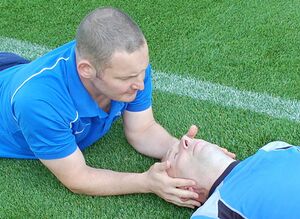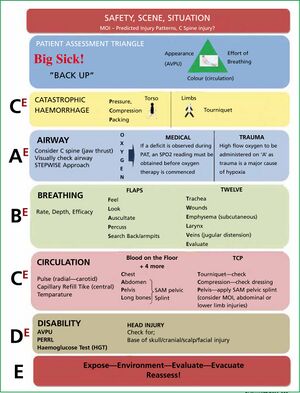Cervical Spine Fractures in Contact Sports: Difference between revisions
Kaya Simon (talk | contribs) No edit summary |
Kaya Simon (talk | contribs) No edit summary |
||
| Line 22: | Line 22: | ||
If the practitioner witnessed trauma to the head or neck, or if their view was restricted and they could not see, then they must immediately perform manual inline stabilisation (MILS) to take control of the head. MILS is a manoeuvre used when a patient has suspected C-Spine trauma to provide a degree of stability to the cervical spine, prior to the application of a cervical collar (Queensland Ambulance Services, 2016). This will help minimise excessive movement and thereby reduce the chance of further injury. To perform MILS the practitioner or assistant should: | If the practitioner witnessed trauma to the head or neck, or if their view was restricted and they could not see, then they must immediately perform manual inline stabilisation (MILS) to take control of the head. MILS is a manoeuvre used when a patient has suspected C-Spine trauma to provide a degree of stability to the cervical spine, prior to the application of a cervical collar (Queensland Ambulance Services, 2016). This will help minimise excessive movement and thereby reduce the chance of further injury. To perform MILS the practitioner or assistant should: | ||
[[File:Mils.jpg|thumb|MILS manoeuvre on field ]] | |||
* Crouch/kneel/lie beside or behind the player | * Crouch/kneel/lie beside or behind the player | ||
** The clinician should attempt to stabilise their elbows/arms on the ground, against another stable object or on their knees to prevent swaying as they become fatigued | ** The clinician should attempt to stabilise their elbows/arms on the ground, against another stable object or on their knees to prevent swaying as they become fatigued | ||
| Line 34: | Line 34: | ||
To assess a patient on the field, the clinician must first perform a primary survey. The first part involves assessing the players alertness, and then includes checking the players airways, breathing and circulation to identify any life-threating injuries. This survey will identify immediately if the player is breathing normally. It will ensure that the medical practitioner is fully aware if they have to carry out immediate interventions that could save the players life. If no immediately life-threatening injuries are present, then the clinician should determine a level of consciousness and conduct a neurological screening. | To assess a patient on the field, the clinician must first perform a primary survey. The first part involves assessing the players alertness, and then includes checking the players airways, breathing and circulation to identify any life-threating injuries. This survey will identify immediately if the player is breathing normally. It will ensure that the medical practitioner is fully aware if they have to carry out immediate interventions that could save the players life. If no immediately life-threatening injuries are present, then the clinician should determine a level of consciousness and conduct a neurological screening. | ||
[[File:Jpar201137366 f01.jpg|thumb|Primary and Secondary Survey]] | |||
'''<u>''Secondary Survey''</u>''' | '''<u>''Secondary Survey''</u>''' | ||
| Line 63: | Line 64: | ||
# Once the spinal board is in place, the player will be rolled back down on, again on the leader’s command | # Once the spinal board is in place, the player will be rolled back down on, again on the leader’s command | ||
# From here, the leader remains in place and another assistant will help place head blocks and straps on. | # From here, the leader remains in place and another assistant will help place head blocks and straps on. | ||
Whilst waiting for an ambulance, the [[Canadian C-Spine Rule]] can be used to determine whether a patient will need a scan. It is applicable to patients who are alert (Glasgow Coma Scale score of 15) and stable condition following [[Overview of Traumatic Brain Injury|trauma]] where [[Cervical Anatomy|cervical spine]] injury is a concern. | |||
== Indications for Surgery == | == Indications for Surgery == | ||
Revision as of 17:53, 16 May 2022
Definition/Description[edit | edit source]
Text
Clinically Relevant Anatomy[edit | edit source]
Text
Pathology[edit | edit source]
Text
Epidemiology[edit | edit source]
Text
Aetiology/Mechanism of Injury[edit | edit source]
Text
Pitch-side Management[edit | edit source]
Management of cervical spine injuries in sport starts from the moment the player goes down on the pitch. Until a cervical spine injury can be definitively ruled out, players need to be handled with the utmost care to prevent exacerbating the injury and causing permanent harm.
Assessing on the Pitch
As pitch-side practitioners do not have the tools nor time to accurately determine whether a player has a C-Spine injury, the most telling sign is usually the mechanism of injury. Prompt identification of any potentially catastrophic injuries is vital. Crosby et al., estimates that 2-5% of blunt trauma patients have a cervical spine injury.
If the practitioner witnessed trauma to the head or neck, or if their view was restricted and they could not see, then they must immediately perform manual inline stabilisation (MILS) to take control of the head. MILS is a manoeuvre used when a patient has suspected C-Spine trauma to provide a degree of stability to the cervical spine, prior to the application of a cervical collar (Queensland Ambulance Services, 2016). This will help minimise excessive movement and thereby reduce the chance of further injury. To perform MILS the practitioner or assistant should:
- Crouch/kneel/lie beside or behind the player
- The clinician should attempt to stabilise their elbows/arms on the ground, against another stable object or on their knees to prevent swaying as they become fatigued
- Place both hands on the patient’s mastoid processes or cradle the occiput
- Apply equal pressure so not to move the head or let it fall
Primary Survey
To assess a patient on the field, the clinician must first perform a primary survey. The first part involves assessing the players alertness, and then includes checking the players airways, breathing and circulation to identify any life-threating injuries. This survey will identify immediately if the player is breathing normally. It will ensure that the medical practitioner is fully aware if they have to carry out immediate interventions that could save the players life. If no immediately life-threatening injuries are present, then the clinician should determine a level of consciousness and conduct a neurological screening.
Secondary Survey
The secondary survey is a detailed head-to-toe examination with the purpose of determining whether the player has suffered any other injuries. This on-field evaluation should include an examination of level of consciousness, cognitive and memory processes, and cranial nerve function, with awareness that significant brain injury is possible. This is determined with the help of an A-E assessment. Maddocks questions are also used to investigate the suspicion of a head injury. They’re 5 questions that are utilised to evaluate orientation as well as assessing short- and long-term memory function. The following is taken from the Sports Concussion Assessment Tool (SCAT). The SCAT is a standardised concussion screening tool used by medical practitioners as an effective pitch-side assessment mechanism:
The neurological evaluation of a conscious player can be used to further investigate potential C-Spine trauma and begins with questions about extremity numbness, painful dysesthesias or paraesthesia, weakness, and neck pain. A physical examination is limited to asking if the patient can move all of their limbs. If there is any gross weakness, numbness, or significant pain to the cervical region, then this could be indicative of a serious neurological deficit. If the athlete is unconscious or presents with any of the below symptoms, then they will need to be extracted off the pitch using a spinal motion-restriction device, such as a spinal board or cervical collar (Fischer et al., 2018).
- Blunt trauma and altered level of consciousness
- Spinal pain or tenderness
- Loss of cervical range of motion
- Neurologic complaint or findings (e.g., numbness or motor weakness in more than 1 limb)
- Anatomic deformity of the spine
Neck Immobilisation and Spinal Board Extraction
The gold standard for neck immobilization is the combined use of a hardboard, collar, sandbags, and tape or straps. This is used primarily during the prehospital transfers and can limit movement to 5% of the normal range (Crosby and Lui, 1990). It should be noted that this type of immobilisation carries a high risk of pressure injury.
Once the collar is secured, the player can be moved onto a spinal board using the log roll technique. The use of the log roll will be applied in 2 scenarios. This will be at matchday or training where there may be a number of experienced and relevantly trained helpers. The other scenario could be where there are no trained helpers, and the medical practitioner will be required to ‘coach’ any assistance. As a note of caution, the best practice could be to not attempt a log roll and to manage the player where they are (Conrad et al., 2012). It may be the case that the initial care given is to keep them warm and to apply oxygen to the player using a non-rebreathe mask with high flow oxygen (15L/ Min).
- To perform a log roll safely, a minimum of 5 people is required
- The leader will be in charge of the head, keeping it MILS and preventing excessive rotation of the neck. The leader will also be the one giving commands to the rest of the group
- Three assistants should be kneeling beside the player, and one will be in charge of moving the spinal board
- The three assistants will place their hands on the opposite side of the player’s body, interlocking their arms.
- On the leader’s command, the assistants will roll the injured player to 90degrees and the spinal board will be slid underneath them
- Once the spinal board is in place, the player will be rolled back down on, again on the leader’s command
- From here, the leader remains in place and another assistant will help place head blocks and straps on.
Whilst waiting for an ambulance, the Canadian C-Spine Rule can be used to determine whether a patient will need a scan. It is applicable to patients who are alert (Glasgow Coma Scale score of 15) and stable condition following trauma where cervical spine injury is a concern.
Indications for Surgery[edit | edit source]
Text
Management and Treatment[edit | edit source]
Text








